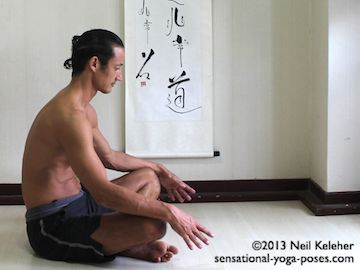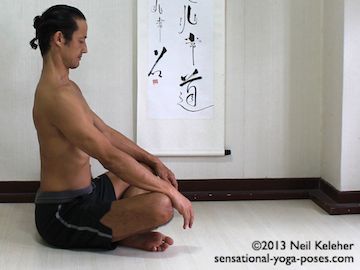Easy Breathing Technique
Making Controlled Breathing a More Comfortable Experience
(formerly titled: Having a Hard Time Breathing)
If you are having a hard time breathing (you have difficulty whenever someone tells you to "breath deeply" or to "focus on your breath"") one solution is to focus on moving your spine and ribcage while you breath.
I call this "easy breathing" because it is relatively easy both to teach and do. And it makes "controlled breathing" a relatively comfortable experience.
I say this because in the past when I've been taught various breathing methods, I've always had a lot of difficulty. One of my chosen challenges has been to teach things in a way that makes them easier to learn. With anything body related, that generally means learning to feel your body so that you can control it more easily.
Easy breathing is a simple breathing method or technique that makes it easy to learn to feel your body. You get the added benefit of mobilizing or moving your spine and ribcage. You thus learn to better feel your spine and ribcage as well as getting practice in controlling them.
Focus on the Body, (and Not the Breath)
I often deal with yoga students whose breathing is very shallow or they gasp or begin their inhales with a sharp intake of breath.
My remedy is to have them not focus on their breath but rather the movements of the body that can cause inhales and exhales to happen. And so I teach them how to breathe by not focusing on their breath but by focusing on their body instead.
Stress Relief Breathing
Often when doing difficult yoga poses or intense stretches I have my students breathe into their nose and out of their mouth. It can feel pleasant to purse the lips while exhaling.
Another method is to hum or chant a "ha" sound while exhaling. While doing so allow your ribs to vibrate. When doing a "ha" exhale I like to open the mouth fairly wide.
Another breathing technique that can feel good and may help to release stress is to curl the sides of the tongue inwards. Poke the tongue through your lips and breath through the "straw shape" created by your tongue. When exhaling release the tongue and breathe normally through the mouth.
Rhythmically Moving the Spine and Ribcage
Since the respiratory diaphragm is buried deep inside the body, I don't often start with diaphragmatic breathing. While it is an excellent breathing exercise or method, I prefer to focus on moving the spine and ribcage since it helps to mobilize spine and ribcage and help my students to feel these parts of the body.
(I know that prior to starting yoga I never really considered my spine and ribcage as flexible entities.)
This can then provide a basis or framework to make learning diaphragmatic breathing (and other breathing methods) easier.
Start with the Tailbone
The spine is made up of over 26 bones. To make feeling and controlling the spine easier, you can start by focusing on one small part of it, the sacrum (and tailbone).
This is the downward pointing triangle of bone between your buttocks.
For this exercise you can sit on the floor with legs crossed.
Another option is to sit on the front part of a chair with your torso upright. You can also do it while standing with your knees slightly bent so that your pelvis can easily tilt forwards and backwards.
- Slowly lift your sacrum while keeping your ribcage upright.
- Then let your sacrum move down.
- As you lift your sacrum feel it moving away from the floor. At the same time feel your lumbar spine bending backwards.
- As you let your sacrum sink down (and curl under) feel your lumbar spine "flattening" or "bending forwards"".
Repeat this exercise slowly and smoothly. Focus on feeling your scarum and lumbar spine. (The lumbar spine is the part of the spine that connects the ribcage to the pelvis.)
Feel and Control Your Thoracic Spine
Continuing the exercise, next focus on feeling your thoracic spine, the part of the spine to which the ribs attach.
- As you lift your tailbone bone feel your lumbar spine bending backwards and carry the back bend up your thoracic spine.
- Then as you relax let your lumbar spine and thoracic spine bend forwards. Feel your chest sinking down.
Note that sinking the chest downward is important. It can feel like you are being a couch potato but that is the goal. Then as you bend your spine backwards starting from this position you get a bigger range of motion. It is then easier to feel (and enjoy) this movement.
Feel and Control Your Ribs
Next continue the same movement but focus on your ribs.
- As you bend your spine backwards slowly reach your ribs upwards.
This may be difficult to begin with. However, you can lead with your mind. Focus on the feeling of reaching upwards and even if you think you've lifted your ribs up as high as possible, continue to think or focus on the feeling of lifting or moving upwards.
- Then as you relax focus on letting your ribs sink down…. all the way down.
Notice Your Breath
As you get comfortable with the movements, then begin to notice your breath.
Rather than trying to control your breath, just notice what happens as you lift your ribs and as you sink them down.
Use the movements of your pelvis, spine and ribs to control your breath.
These movements should be naturally creating your inhales and exhales.
To make your inhales and exhales deeper try to make the movements bigger.
- Increase the back bend of your spine and lift your ribs higher to increase your inhale and sink your ribs more to deepen your exhale.
- The smoother you make the movements the smoother your breath will be.
Listen to the Sound of Your Breath
Next pay attention to the sound of your breath.
- Especially at the beginning, as you lift your ribs, look for a sudden gasp of air instead of a smoothly starting inhale.
- See if you can start your inhales smoothly so that their is no gasp at the beginning.
Differentiate Your Chin and Your Chest
Note that lifting the chest is not the same as lifting the chin. I have some students who have difficulty with this breathing exercise to begin with and as they lift their chest they lift their chin.
Lengthening the Back of Your Neck
Once you have the feeling for lifting your ribs and bending your spine (while inhaling) you can add a chin tuck or focus on making the back of your neck feel "open".
(This is actually a good way to practice getting rid of (or at least controlling) Forward Head Posture.)
It's also a good start to fixing your posturein general.
I usually instruct "pull the ear holes back and up" or you could sit with your back against a wall and reach the back of your head up and back to touch the wall while opening your chest.
You can then use this same breathing method while doing yoga poses.
These are like some regular yoga postures except instead of staying still you move while holding these postures. The movements are exactly the same as what you have just been practicing.
The most important thing is to make this breathing exercise feel good. You may find that the slower and smoother you do the movements the better they feel. And then you are ideally no longer having a hard time breathing.
Once you are comfortable with this "Easy Breathing" technique you may find it beneficial to experiment with Costal Breathing. For more details on the anatomy of breathing and how to learn diaphragmatic breathing check out Breathing Anatomy for Yoga Teachers.
Published: 2011 01 02
Updated: 2019 08 11




